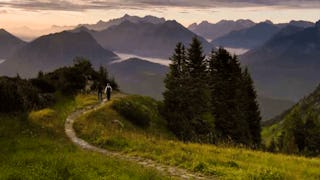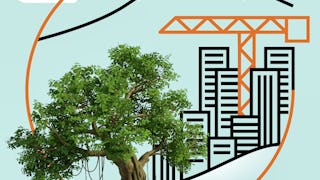Mountains 101 is a broad and integrated overview of the mountain world. This 12-lesson course covers an interdisciplinary field of study focusing on the physical, biological, and human dimensions of mountain places in Alberta, Canada, and around the world. Specifically, we'll study the geological origins of mountains, how they’re built-up and worn-down over time; we’ll learn about their importance for biodiversity and water cycles, globally and locally; we’ll explore their cultural significance to societies around the globe, and how that relationship has evolved over time; and we’ll learn how mountains are used, how they’re protected, and how today they’re experiencing rapid change in a warming climate.

Enjoy unlimited growth with a year of Coursera Plus for $199 (regularly $399). Save now.

(2,573 reviews)
Skills you'll gain
Details to know

Add to your LinkedIn profile
12 assignments
See how employees at top companies are mastering in-demand skills

There are 12 modules in this course
In this introductory lesson, you will learn why mountain environments are relevant to people all around the globe. We’ll also define just what a “mountain” is in order to show why it is useful to think about mountains from various perspectives. TechTip: Your feet are your vehicle
What's included
4 videos3 readings1 assignment
In Lesson 2, we discuss why mountains are located where they are. How did they get there? We’ll explore the physical origins of mountains, theories of mountain building, and how our changing ideas about mountains and their genesis have shaped our engagement with them. TechTip: Dress for success
What's included
5 videos2 readings1 assignment
Mountains influence climate and weather at both global and local scales. In Lesson 3, we will examine how elevation affects atmospheric processes, and discuss an ecological manifestation of mountain climate: the alpine tree line. TechTip: What goes in your pack?
What's included
4 videos2 readings1 assignment
Lesson 4 explores some of the physiological responses that allow humans to visit higher altitudes, as well as the unique genetic adaptations that permit long-time exposure to the world’s high places. TechTip: Stay found – preparation
What's included
4 videos2 readings1 assignment
Lesson 5 focuses on mountain hydrology. We'll discuss the ways that water moves through the mountain landscape, how water shapes and changes mountain landscapes, and we'll introduce some hazards associated with water, such as glacial lake outburst floods. TechTip: Stay found – in the field
What's included
5 videos2 readings1 assignment
Lesson 6 focuses exclusively on glaciers, their physical composition and processes, how they form and move, and how they modify the landscape. We’ll also examine how our changing understandings of glaciers have shaped the ways people have engaged with mountain landscapes over the past few centuries. TechTip: Stay safe – from falling
What's included
5 videos2 readings1 assignment
In Lesson 7, we examine some of the ways people have imagined mountains throughout time, and try to place those ideas and attitudes in their respective cultural contexts. Appreciating the diversity of views – their reception in oral traditions, art, literature, architecture, and other cultural forms – gives us some context for the more dominant ways we think about and celebrate mountains today. TechTip: Stay safe – winter challenges
What's included
3 videos2 readings1 assignment
Mountain hazards are the focus of Lesson 8, specifically snow avalanches, landslides, and volcanoes. We will examine the physical processes that lead to instability in mountain landscapes and consider how risks associated with hazards can be managed. TechTip: Stay safe – avalanche safety (know before you go)
What's included
4 videos2 readings1 assignment
In this Lesson 9, we discuss the ecological and evolutionary processes that account for the remarkable biodiversity of species living in mountain environments. Then, we explore some of the unique adaptations that plants have for coping with extreme conditions, including cold, intense solar radiation, and short growing seasons. TechTip: Go farther – camping
What's included
6 videos1 reading1 assignment
Animals living in mountains have evolved morphological, behavioural, and physiological adaptations to survive under extreme conditions. In Lesson 10, we will focus on how several species deal with the cold and conclude with a peek at the adaptations of fish living in mountain lakes. TechTip: Go farther – cooking
What's included
4 videos1 reading1 assignment
How are mountains used? How are they preserved? In Lesson 11, we examine the often conflicting demands of using mountains, and preserving and managing the integrity of mountain environments, cultures and economies. TechTip: Go softly – mountain ethics
What's included
4 videos2 readings1 assignment
In Lesson 12, we will look forward and consider some possible future scenarios for mountains. How is our changing climate affecting these places? What are the indicators of change? What lessons can we learn from the past and present to inform decisions for tomorrow?
What's included
3 videos1 reading1 assignment
Instructors


Offered by
Explore more from Environmental Science and Sustainability
 Status: Free Trial
Status: Free Trial Status: Free
Status: FreeUniversity of Alberta
 Status: Preview
Status: PreviewUniversity of Geneva
 Status: Preview
Status: PreviewUniversity of Zurich
Why people choose Coursera for their career




Learner reviews
2,573 reviews
- 5 stars
90.55%
- 4 stars
8.23%
- 3 stars
0.81%
- 2 stars
0.11%
- 1 star
0.27%
Showing 3 of 2573
Reviewed on Dec 22, 2017
So interesting! So well made, every lesson is thought out the interactive mountain map was a joy to complete each time! Incredibly thoughtful and sensitive to every aspect that touches the mountains.
Reviewed on Aug 9, 2020
Awesome content and video production. Very interesting and covers a wide range of topics. As some that enjoys mountain recreations, it is a good primer on the environment I spend so much time in.
Reviewed on Jan 7, 2021
An excllent introduuction to mountains and the complex interactions that occur there. I really enjoyed the interdisciplinary components and the human interaction in the course. Well done U ofA!

Open new doors with Coursera Plus
Unlimited access to 10,000+ world-class courses, hands-on projects, and job-ready certificate programs - all included in your subscription
Advance your career with an online degree
Earn a degree from world-class universities - 100% online
Join over 3,400 global companies that choose Coursera for Business
Upskill your employees to excel in the digital economy
Frequently asked questions
To access the course materials, assignments and to earn a Certificate, you will need to purchase the Certificate experience when you enroll in a course. You can try a Free Trial instead, or apply for Financial Aid. The course may offer 'Full Course, No Certificate' instead. This option lets you see all course materials, submit required assessments, and get a final grade. This also means that you will not be able to purchase a Certificate experience.
When you purchase a Certificate you get access to all course materials, including graded assignments. Upon completing the course, your electronic Certificate will be added to your Accomplishments page - from there, you can print your Certificate or add it to your LinkedIn profile.
Yes. In select learning programs, you can apply for financial aid or a scholarship if you can’t afford the enrollment fee. If fin aid or scholarship is available for your learning program selection, you’ll find a link to apply on the description page.
More questions
Financial aid available,

